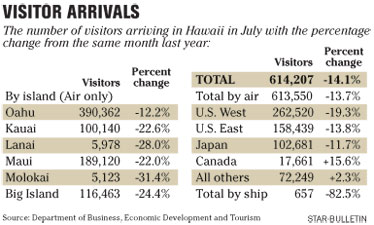Summer visits offer no relief
Double-digit slumps in arrivals and visitor spending come during tourism's peak season
STORY SUMMARY »
Visitor numbers for Hawaii are in a summer slump during what is usually the peak tourism season of the year.
Visitors in July were in a double-digit decline for every U.S. region and Japan compared to last July, according to statistics released yesterday by the state Department of Business, Economic Development and Tourism.
Total arrivals by air and cruise ship for July fell 14.1 percent compared to July 2007, continuing the same slump as in June, when they were down 14.2 percent over the previous year, the worst drop since June 2003.
Visitor expenditures also were down double digits on every isle except Oahu, as Hawaii's tourism industry feels the impact of a slowing national economy, rising fuel prices and the loss of two cruise ships, which accounted for an 82.5 percent drop in total arrivals by ship.
Only 657 visitors came to Hawaii on one out-of-state cruise ship in July, compared to 3,753 on three cruise ships last July.
FULL STORY »
The visitor industry in Hawaii is in a summer slumber that may not pick up any time soon.
Both the number of visitors to Hawaii and visitor expenditures continued double-digit declines for July, according to the latest statistics released yesterday by the state Department of Business, Economic Development and Tourism.
The total number of arrivals by air and cruise ship fell 14.1 percent last month compared to July 2007, continuing the downward slump experienced in June, when the year-over-year drop in total arrivals was at 14.2 percent, the worst drop since June 2003.
Total visitor days for air and cruise visitors last month also were down by 12.9 percent.
This slump comes during the middle of Hawaii's peak tourism season, which typically runs from June to August.
Marsha Wienert, state tourism liaison, said that prior to June and July, Hawaii's visitor market had managed to weather the softness felt by other travel destinations as a result of the slowing national economy.
But the July statistics mean the visitor industry is significantly impacted not only by the slowing national economy, said Wienert, but by rising fuel prices and the loss of two Norwegian Cruise Line ships.
Visitors by air dropped 13.7 percent in July, which was higher than the 13.5 percent drop in June.
Total air visitor expenditures also dropped 14.9 percent - or $177.3 million - to $1 billion in July this year compared to the same month last year. In June, air visitor expenditures dropped 13.5 percent.
Year-to-date visitor spending for the first seven months declined 5 percent to $7 billion.
All this comes on the heels of a decision by the Hawaii Tourism Authority - after hours of deliberation - to let President and Chief Executive Rex Johnson keep his job, with a reduction in pay to $200,000 from $240,000 annually.
Johnson will remain at HTA's helm, despite getting caught using his state computer to send pornographic e-mails.
Much of the testimony in support of keeping Johnson came from those in the tourism industry who feared Hawaii's economy would suffer further if HTA fired its top executive.
Cruise ship loss
The loss of the two NCL cruise ships alone accounts for an 82.5 percent drop in total arrivals by ship. Only one out-of-state cruise ship came to Hawaii in July, bringing 657 visitors, compared to three ships that brought 3,753 visitors in July of last year.
The loss can be blamed for 83.7 percent of Kauai's decline in arrivals, according to Wienert, and 65 percent of the Big Island's decline in arrivals.
Year-to-date, only 52,250 visitors came by cruise ship, down 22.5 percent from the same period last year.
Nevertheless, Wienert sees the cup as half full instead of half empty.
"Even with the current challenges, our visitor industry is resilient and there is great potential in developing visitor markets," she said.
The bright spot was the 15.6 percent growth recorded in Canadian visitor arrivals for July, which also experienced double-digit growth in May and June compared to the same months last year.
There were more first-time visitors from Canada in July than the same time last year, and they stayed an average of 11.72 days, up from 11.55 days in July 2007.
But Canadians for the first seven months of this year seemed to favor Maui over other Hawaiian isles. Maui was the only island to record an increase in Canadian arrivals.
Wienert also said the easing of travel restrictions for Korean and Chinese visitors means the "other Asia" market potentially could double in arrivals and spending over the next few years.
Double-digit declines
However, every U.S. mainland region showed double-digit declines in visitor arrivals this July compared to last July.
Arrivals from the U.S. West dropped 19.3 percent while arrivals from the U.S. East fell 13.8 percent.
Every island also experienced double-digit declines in air arrivals in July, with Molokai experiencing the largest drop at 31.4 percent, followed by Lanai at 28 percent, the Big Island at 24.4 percent, and Kauai at 22.6 percent. Maui experienced a 22 percent drop in air arrivals, and Oahu a 12.2 percent drop.
Visitors from Japan also dropped 11.7 percent in July, contributing to a 3.7 percent drop in total expenditures from the market to $163.8 million.
With lower consumer confidence, visitors in Hawaii are more cautious about spending. All islands reported lower visitor expenditures this month compared to July 2007 - they were down 27.4 percent on Maui, 28.3 percent on the Big Island, 17.8 percent on Kauai and 2.8 percent on Oahu.
For Oahu, the decline was shored up by a 5.6 percent increase in daily spending to $194 per person, up from $184 per person last July.


